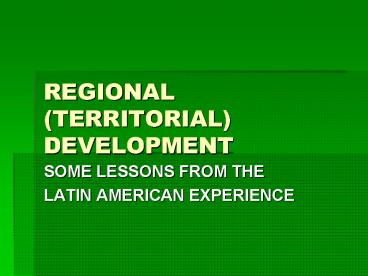REGIONAL TERRITORIAL DEVELOPMENT - PowerPoint PPT Presentation
1 / 13
Title:
REGIONAL TERRITORIAL DEVELOPMENT
Description:
PERU AND ECUADOR. Peru: Good Macro-economic environment. High levels of inequality ... In Bolivia and Ecuador, decentralization was already underway. ... – PowerPoint PPT presentation
Number of Views:60
Avg rating:3.0/5.0
Title: REGIONAL TERRITORIAL DEVELOPMENT
1
REGIONAL (TERRITORIAL) DEVELOPMENT
- SOME LESSONS FROM THE
- LATIN AMERICAN EXPERIENCE
2
Key Concepts / Definitions
- Regional Policy
- Regional Policies
- Territorial Development
- Considerations
- Context
- Entry Points
3
PERU AND ECUADOR
- Peru
- Good Macro-economic environment
- High levels of inequality
- High social risks
- High diversity
- Quality of Life
4
Ecuador
- Specific Province (Chimborazo)
- Strong Leadership
- Support from Central Government
- Law of Fiscal Responsibility infrastructure
investments
5
TERRITORIAL DEVELOPMENT AND DECENTRALIZATION
- Peru Decentralization Law of 2002 gave the
Regions (departments) full responsibility for
economic development. - Pilot activities were designed to facilitate the
implementation of the new law and test different
models of economic development (PROCUENCA,
FONCODES) - Decentralization presented several challenges
fiscal issues, competencies at each level of
government, assessment of local capacity,
mechanisms for promoting economic development. - Along with macro-level policies (e.g. a rigorous
system of public investment monitoring), the
territorial approach was introduced in selected
regions as a mechanism to facilitate
decentralization. - In Bolivia and Ecuador, decentralization was
already underway. - Different approaches to respond to different
circumstances.
6
INSTITUTIONAL CHALLENGES
- How to integrate existing sectoral programs with
a new strategy? - How to finance the new strategies? Fiscal Issues
- Who should lead? The Central Government, Regional
Government? Municipalities? - What programmatic and project mechanisms should
be used? - How could it be implemented?
- How should it be monitored?
7
THE TERRITORIAL APPROACH OFFERED THE BEST OPTION
WHY
- It provided a framework to establish investments
priorities taking into account the economic,
social, cultural and physical assets of a
particular territory. - It promoted multi-sectorial collaboration.- An
effective use of public and private resources was
best achieved when national programs supported a
clear and well-defined strategy. - It helped bring discipline to public investments
based on a strategic economic plan and taking
advantage of economies of scale.
8
THE TERRITORIAL APPROACH WHY ?
- It helped promote social cohesion by involving
local stakeholders and promoting local alliances,
building a consensus on the future of the area. - It helped strengthen local identity improving the
possibility of retaining potential immigrants. - It provided the basis for more effective decision
making and greater institutional accountability.
9
WHAT PROCESS WAS FOLLOWED
- Identifying territorial or regional typologies
through territorial analysis In Peru, the areas
selected were those with the highest impact from
the violence of the 80s, in Ecuador, a province
with a diverse geographic composition of i)
territories with dynamic agricultural and
agro-industrial entrepreneurial activity ii)
micro-regions with dynamic small family-based
productive units iii) areas of extensive
agriculture iv) depressed rural areas. In
Bolivia, areas with economic potentia (clusters
of municipalities) - Starting with Regional Strategic Planning as
the instrument for economic coordination and
efficient investment plans. - Finding the appropriate entry point e.g.,
infrastructure (Ecuador) rural alliances (Peru
and Bolivia) information technology
(Extremadura) tourism (Calabria, Northern Spain).
10
WHAT PROCESS WAS FOLLOWED?
- Strengthening or building local and middle-level
institutions (governance) e.g. Local Action
Groups (Leader-EU) FUMACs (Brasil) Rural
Development Councils (Mexico, Brasil) Mesas de
Concertacion (Peru) Joined Municipalities
(mancomunidades-Bolivia) Cluster Advisory
Councils (Ecuador, Colombia), MOUs - Promoting Partnerships- e.g., establishing
incentives to form associations among the public,
private and civil society sectors. - Making use of local assets natural, social,
cultural, physical, economic, demographic.
11
KEY LESSONS LEARNED SO FAR..
- A Multi-sectorial approach works best at the
local level the most successful cooperation
across sectors was achieved at the local level,
when there was a clear strategy for development
and consensus a vision of the future. - Clarification of roles at each level of
government was central multiple and sometimes
overlapping responsibilities and competencies of
different levels of government present a
challenge - The Central Government role - responsible for
regulating, coordinating, facilitating and
monitoring program implementation. - The Regional and Municipal Governments role -
responsible for promoting and providing public
goods type of services e.g., facilitating the
participatory process for economic strategies and
economic alliances, providing intraregional
infrastructure, information, environmental
management and related services.
12
.LESSONS LEARNED SO FAR.
- Establishing a competitive financing mechanism
with clear eligibility criteria for co-financing
strategic investments (rules of the game)- - The demographic and geographic diversity of a
region may call for different eligibility
criteria for different types of investment
programs. For example in Peru, the Territorial
Development Fund would have three windows, each
with its own selection criteria and targeted to
different segments of the population. - i) to promote agricultural diversification and
reduce malnutrition - ii) for producer associations in alliance with
the private sector, NGOs, academic institutions - iii) for regional level programs with alliances
between local governments and other partners, e.g
municipalities, local communities and local NGOs
to establish appropriate environmental management
interventions.
13
. LESSONS LEARNED
- Promoting partnerships and productive alliances
for implementation of key strategic economic
activities that would enhance the quality of life
and economic productivity of the area and would
promote the development of a local market of
services. - Impact of the Territorial Approach depends on the
level of political commitment of the actors
involved. Developing consensus on key strategic
areas of action, establishing clear rules of the
game, providing timely information, allocating
resources accordingly and showing early success
are key for the overall impact of the regional
strategy. - Regional/Territorial Development is still
evolving in Latin America. It is work in
progress.






























